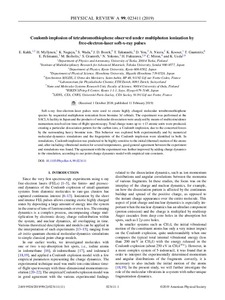Coulomb implosion of tetrabromothiophene observed under multiphoton ionization by free-electron-laser soft-x-ray pulses
Pelimanni E; Kooser K; Fukuzawa H; You D; Nagaya K; Niozu A; Myllynen H; Berholts M; Granroth S; Bozek JD; Gaumnitz T; Miron C; Wada S; Takanashi T; Kukk E; Ueda K; Yokono N
Coulomb implosion of tetrabromothiophene observed under multiphoton ionization by free-electron-laser soft-x-ray pulses
Pelimanni E
Kooser K
Fukuzawa H
You D
Nagaya K
Niozu A
Myllynen H
Berholts M
Granroth S
Bozek JD
Gaumnitz T
Miron C
Wada S
Takanashi T
Kukk E
Ueda K
Yokono N
AMER PHYSICAL SOC
Julkaisun pysyvä osoite on:
https://urn.fi/URN:NBN:fi-fe2021042824204
https://urn.fi/URN:NBN:fi-fe2021042824204
Tiivistelmä
Soft-x-ray free-electron-laser pulses were used to create highly charged molecular tetrabromothiophene species by sequential multiphoton ionization from bromine 3d orbitals. The experiment was performed at the SACLA facility in Japan and the products of molecular dissociation were analyzed by means of multicoincidence momentum-resolved ion time-of-flight spectroscopy. Total charge states up to +13 atomic units were produced, creating a particular dissociation pattern for the carbon ions, a Coulomb implosion, due to the concerted forces by the surrounding heavy bromine ions. This behavior was explored both experimentally and by numerical molecular-dynamics simulations and the fingerprints of the Coulomb implosion were identified in both. In simulations, Coulomb implosion was predicted to be highly sensitive to the initial (thermal) motion of the atoms and, after including vibrational motion for several temperatures, good general agreement between the experiment and simulations was found. The agreement with the experiment was further improved by adding charge dynamics to the simulation, according to our point-charge dynamics model with empirical rate constants.
Kokoelmat
- Rinnakkaistallenteet [19249]
